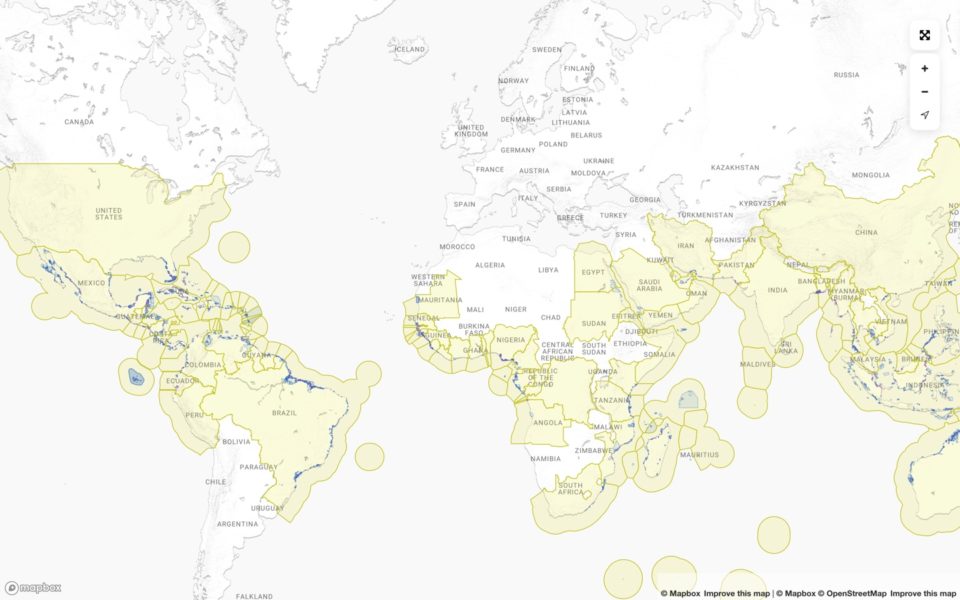
Global Mangrove Watch platform updated with the latest data to 2020
-
Coastal wetland conservation
-
Global Mangrove Watch
The primary source of information on mangroves’ status and extent – used by scientific bodies, think tanks like the World Resources Institute, project developers, and international and regional policymakers, including government bodies, and the UN – the Global Mangrove Watch platform (GMW), has been updated with the latest data to 2020.
The GMW platform uses JAXA’s ALOS data, USGS LandSat data, and ESA’s Sentinel-2 data along with local expertise to track the relative gain and loss of mangroves across the planet. It is the only platform of its kind which accurately maps not only loss and gains in mangroves globally, but also which mangroves are protected, how much carbon they can store in both aboveground biomass and mangrove soil, and presents this information in a way that is relevant for policy. It is free for anyone to use.
The latest data is featured in the second edition of the State of the World’s Mangroves report which shows that:
- The trend from 1996 to 2020 is a net decline of 5,245 km2 in mangrove extent, globally. There has been a reduction of 3.4% of our planet’s mangroves since 1996, with the biggest loss occurring in Asia (2813 km2 or 4.6%), Africa (648 km2 or 2.2%) and the Pacific (524 km2 or 3.1%)
- The most common cause of mangrove loss is clearance and conversion to farmland, agriculture, and/ or urbanization
- 8,183 km2 of mangroves are considered restorable, of which 2,000km2 are in Indonesia.
- Full restoration of the entire 8,183km2 could result in an additional 50 billion commercial marine species and benefit the countless communities that rely on fishing for their livelihoods.
- Restoration of losses since 1996 could safeguard carbon in soil and aboveground biomass equivalent to 1.27gigatons of CO2

The determination to safeguard mangroves is growing at all levels from international to local. With this new update, Global Mangrove Watch provides an accurate regional and national mangrove baseline for encouraging and supporting the development of policies and management plans for the sustainable use and restoration of mangroves. The platform is being continually updated with new datasets and several tools will soon be launched to support policy development and tracking of restoration progress and success.
Lammert Hilarides, Senior Technical Officer at Wetlands International said:
“When we see the other mapping tools, for everything from tree cover to fishing, and we consider the incredible value mangroves have in building resilience to climate change, creating a platform that accurately tells the global story of mangroves is a no-brainer. The global mangrove watch platform is the combined effort of space agencies, scientific institutions, companies, NGO’s and their local partners which recognizes that while space may be the final frontier, our planet is still our only home and mangroves play a significant role in ensuring the longevity of life on Earth.”
The GMW platform is the evidence base informing the Global Mangrove Alliance and is the result of years of continuous collaboration between local and international scientific, research, environmental organisations, and foundations including Wetlands International, The Nature Conservancy, SoloEO, Aberystwyth University, The Japan Aerospace Exploration Agency, NASA, WWF, the IUCN, and supported by the Oak Foundation, COmON Foundation, DOB Ecology, and the Dutch Postcode Lottery.
Notes for editors
(1) To see the raw data click here
(2) https://www.sciencedirect.com/science/article/pii/S2666017221000055
Contacts:
Mark Spalding, Senior Scientist with The Nature Conservancy
email: [email protected]
Lammert Hilarides, Senior Technical Officer with Wetlands International
email: [email protected]
Susanna Tol, Senior Advocacy Officer with Wetlands International
email: [email protected]
Emma Barnes, Ocean Communications, WWF
email: [email protected]
